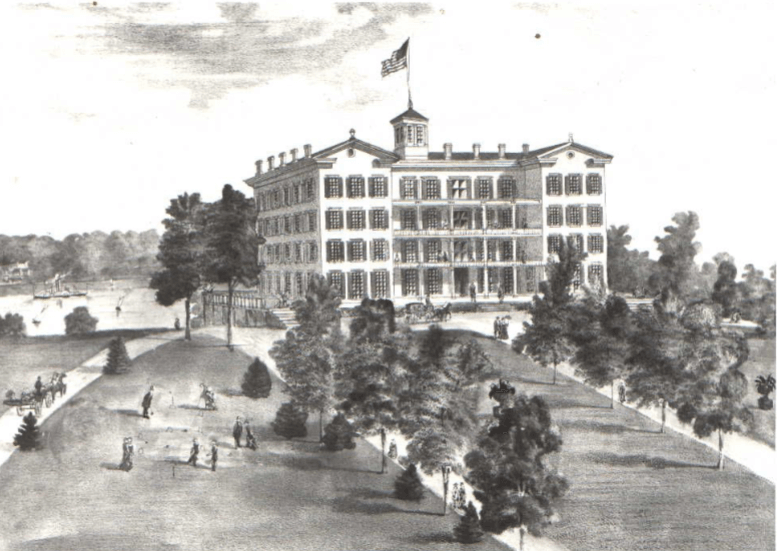Nyack-on-Hudson, as it liked to refer to itself in the 1870s, was a perfect place for a summer resort. Nyack sported at least 8 hotels and several boarding schools that housed summer guests. Seven daily trains including an express, three steamboats, and a ferry to Tarrytown brought hundreds to Nyack from June to late September. Many stayed the summer.

How did it come about that Nyack became a preferred destination? What made it so popular? Where were those 8 hotels located and what happened to them? Here is the story.
Cholera Pandemic Brings Visitors to Nyack
The first hotel in Nyack was C. T. Smith’s Mansion House built in 1827 at the northeast corner of Main and Broadway. In 1832, America’s first cholera epidemic struck New York City. People panicked. They lined docks to grab a boat without any real concern about the destination. Some 80 people found residence and meals at the Mansion House. Overflow guests filled nearby private homes. People must have enjoyed their stay. Word of mouth about Nyack’s healthy environment made it to the city. Nyack became known. Hotels sprang up to meet the need over the next 50 years.

What Was Nyack’s Appeal in the 1870s?
Nyack was a village of some 3,000 in the 1870s. The fact that the village was small and off the beaten track was its charm. The New York media picked up on Nyack’s healthful environment.
“Nyack’s hillside, river sides, and quiet, country lanes…Its healthfulness is common talk, and its quiet comforts are greatly appreciated. Nyack’s progress has been rapid of late years on account of its increasing favor as a summer resort”
New York Daily Tribune, July 12, 1872

Nyack was easier to get to from NYC than the upstate resorts at Saratoga and Ballston Springs. Nyack was so close to NYC that working husbands could visit during the weekend throughout the summer season from end of May to mid-September. Some husbands made the commute daily. Even more important than its easy accessibility, Nyack offered a haven to avoid hot, smelly cities loaded with dangerous diseases in the summer: typhus, yellow fever, cholera, and others.
Nyack Hotels During the Resort Era

Nyack had an ever-changing list of hotels in the post-Civil War era. Back in the day, owners avoided the word “hotel”. Common thinking was that tourists would “shudder” at the word. Instead “boarding house” was the preferred term, a term we might shudder at today. “House” was the most common appellation. Names changed often to suit new owners and to better fit the marketplace. The largest were in South Nyack. Others dotted the waterfront in downtown Nyack.
South Nyack Resorts in the 1870s
Tappan Zee House

The Rockland Female Institute opened as a college for women in 1856. During the summer months, it became a riverfront hotel known as the Tappan Zee House. The four-floor riverfront edifice with a cupola housed up to 100 guests along with a large separate villa and cottages. It had a handsome tree-lined entrance from Piermont Ave. Guests enjoyed billiards, croquet, bathing on a pebbly beach, carriage riding and riding horseback.
The Clarendon
Run by Mrs. H. B. Adams, the Clarendon was near the Tappan Zee House on Piermont Ave. in South Nyack. The Clarendon took pride in its wide lawns and croquet courts. The Clarendon was in decline late in the 19th century when there was some talk of moving it to the grounds of the Tappan Zee house. It burned down in 1908.
The Ross Mansion

During the 1870s, Azariah Ross rented out his 22-room house on S. Franklin Street near the train station as a hotel. Ross’s handsome gothic revival estate built in 1859 on 4 acres was a hit with summer visitors, “who believed in comfort more than in style” according to the local paper. Acquired by the Hand family in the 1880s, the Ross Mansion became again a private home known now as the Ross-Hand mansion.
Palmer House/Prospect House

The Palmer House was Nyack’s largest hotel and by far it most elaborate. Built by a Philadelphian, Matthew Baird, it soared some 400 feet above the river on South Highland Ave. Run by Mrs. Palmer, the hotel had a reputation for catering to the wealthy in its large dining hall. It did so well, that Mrs. Palmer and her daughter would head to Europe at the end of the season. Guests, dressed to the nines, filled the regular balls and hops. The name became the Prospect House after a change in ownership. It had extensive horse trails, croquet courts, cottages, and a bowling alley. Its river views were the best in Nyack. A dramatic 1898 fire destroyed the hotel and its contents.
Downtown Hotels of the 1870s
St. Nicholas
St. Nicolas was one of the first hotels to be constructed on Main Street shortly after the Civil War. It was a “city’ style hotel with a bar, public meeting space, and retail shops. The hotel was run for a time by Louis Hoffer who was later to build Nyack’s Opera House.

York House
Another of the ‘downtown’ hotels, the York House was in business by 1850 on the southwest corner of Main St. and Piermont Ave. It housed several businesses, hosted traveling daguerreotype artists, and put-up business travelers. It lasted until the turn of the century although it was much run down by then.
Dry Dock Hotel
Another old-time small downtown hotel, the Dry Dock Hotel opened before 1836 at the northeast corner of Main and Gedney. The hotel was run by Isaac Canfield. For a time, it was the location of Nyack’s Post Office when Canfield was postmaster.

Smithsonian
Located near the public docks at the foot of Burd and Main, the Smithsonian was refurbished for the summer resort market. It had a noted livery and a year-round trade in transient guesst. A later addition provided a public meeting space on the second floor, Smithsonian Hall. It was a smaller hotel but convenient to the docks and natural air conditioning from river breezes.

The Special World of Downtown’s Pavilion Hotel
One of the earliest, most popular, and longest lasting of the resort hotels was known as the Pavilion located on a hill above Main at Mill Street. Its halcyon years preceded photography, so we have no known photographs to appreciate its appeal. Maps show a carriage entrance on Main St. and a circular drive. The Pavilion’s beautiful, terraced grounds and river views attracted regulars for several decades.

According to local Nyack historian James Leiner, Theodore Gregory opened the first iteration of the Pavilion in 1831 under the name Eastern House, so named because of its river view to the east. It was then a low, flat structure for about 70 guests. It was greatly expanded in mid-century.
Abram P. Smith purchased the 4-acre hotel property in 1849. The hotel was known as Cedar Hill around 1860 and renamed the Pavilion Hotel, more commonly known as the Pavilion. At times it was referred to and sometimes advertised affectionately as A.P. Smith’s. The hotel had a family ambience and counted on return guests. A favorite activity was sitting on the porch watching the busy river traffic and the ducks swimming in the Nyack Brook mill pond just below the hotel.

The Mill at the Pavilion
It was a hotel that came equipped with an old mill built by Tunis Tallman as a grist mill in the 18th century. Abram Smith continued to run the mill after he acquired the Pavilion. In the 1860 census, Smith listed his occupation as “miller.” He expanded the mill adding facilities for sawing and planing. It was a unique historical attraction for vacationers. Like the hotels, it too would disappear.
End of the Resort Era
By the end of the 19th century the tidal wave of summer guests moved on to new destinations. One by one the hotels disappeared until by WWI all but the Ross-Hand Mansion were gone. All things must change but just for one moment imagine the possible vacation choice of the 1870s. Imagine a magical steepled resort high on a downtown hill and an 18th century mill below it along the Nyack Brook. Then think of swimming at the pebbly Hudson beach in South Nyack, then enjoying a picnic lunch beneath a shade tree. Imagine an evening outdoor clambake on the green hills of South Mountain overlooking Nyack and Hook Mountain. It was great fun while it lasted.

Michael Hays is a 35-year resident of the Nyacks. Hays grew up the son of a professor and nurse in Champaign, Illinois. He enjoyed a long career in educational publishing with Prentice-Hall and McGraw-Hill. He s currently president of the Historical Society of the Nyacks and vice president of the Edward Hopper House Museum & Study Center. Hays is an avid cyclist, amateur historian and photographer, gardener, and dog walker. He has enjoyed more years than he cares to count with his beautiful companion, Bernie Richey. You can follow him on Instagram as UpperNyackMike.








